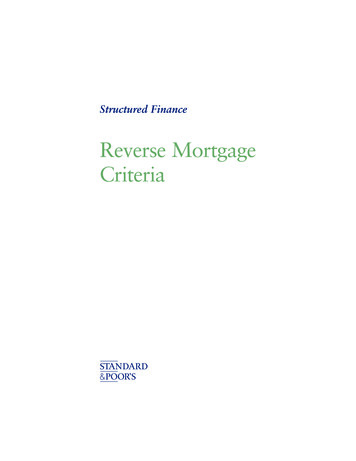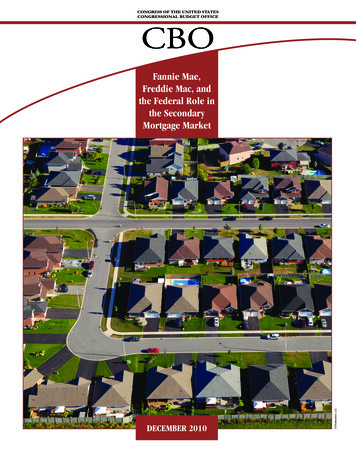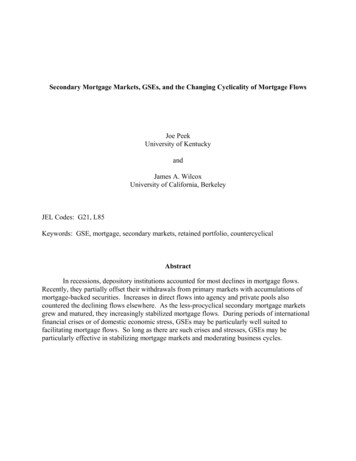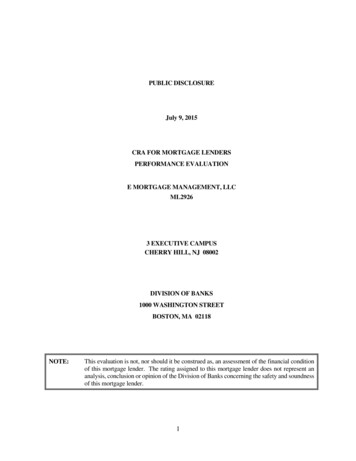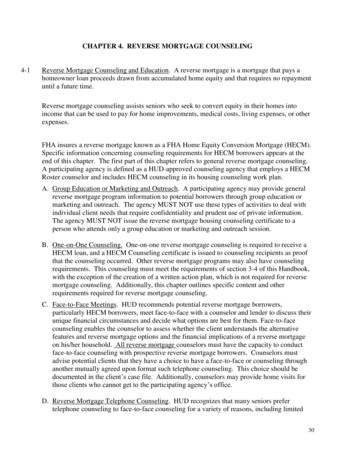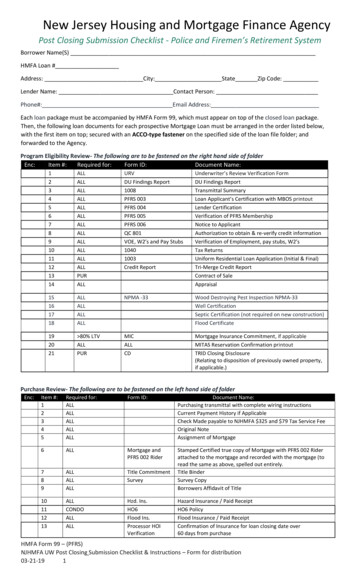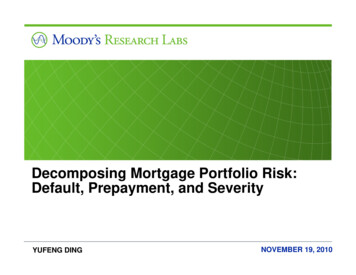
Transcription
Decomposing Mortgage Portfolio Risk:Default, Prepayment, and SeverityYUFENG DINGNOVEMBER 19, 2010
Overview» The loss on a mortgage portfolio is an aggregate of the losses of the loans in theportfolio» The loan behaviors that have direct impacts on loan losses:– A loss may occur if a loan defaults. The magnitude is determined by severity, or loss-givendefault of the loan.– If a loan prepays, there will be no loss on this loan. Statistically, higher prepayment probabilityreduces the chance for a loan to default.» Default, prepayment and severity are all affected by loan and borrower characteristicsand macro economic factors. A factor may have an intuitive relationship with theindividual behaviors, but not necessarily so with loan loss.» MPA integrates the individual models through their dependence on common (especiallyeconomic) factors in a quasi-structural way to generate the loan level losses in a naturalway. This correlates the loans in a natural way.» Loan level losses are then aggregated to get the pool level losses.Decomposition simplifies complicated processes. Re-integration gets it backto the complex real world.Decomposing Mortgage Portfolio Risk: Default, Prepayment, and Severity - Nov 20102
Mortgage Modeling: Overview IIOutputDefaultscenario)Loan LevelPool Data(User data)Supplementaluser data(loan leveloverride, poolperformance,etc.)SeverityPrepaymentΣPool Level E(L)Economic Data(simulated orMODELSLoan Level E(L)FACTORSDecomposing Mortgage Portfolio Risk: Default, Prepayment, and Severity - Nov 20103
Agenda1. Building the component models» Default / Prepayment models» Severity model2. Simulating macro economic factors3. Putting it altogether: Mortgage Portfolio Analyzer4. ConclusionDecomposing Mortgage Portfolio Risk: Default, Prepayment, and Severity - Nov 20104
1. Building the component models» Default / Prepayment models1» Severity model2. Simulating macro economic factors3. Putting it altogether: Mortgage Portfolio Analyzer4. ConclusionDecomposing Mortgage Portfolio Risk: Default, Prepayment, and Severity - Nov 20105
Default/Prepayment models: Cox regression» Default/Prepayment: Cox Proportional Hazard Model is a natural choice.– Both default and prepayment are discrete events.– Both are affected by many factors (macro economic factors, loan characteristics and etc.).– Both are affected by seasoning (age) of the loan in a highly non-linear way.» Cox Proportional Hazard Modelhi (t) h0 (t) eβ’x– In the equation, i indicates ith loan. t indicates loan age.– hi (t) is the hazard rate we want to estimate. More specifically, it is the probability of ith loan todefault or prepay conditional on that it has survived till time t.– h0 (t) is the baseline hazard of all loans (of the same type) on average. It is a non-parametricfunction of t and captures differences in loan behavior throughout a loan’s life.– The β’xi in the exponential term is the regression component. It, as in any other regression,estimates the β coefficients for the factors.Cox model offers both flexibility and interpretability.Decomposing Mortgage Portfolio Risk: Default, Prepayment, and Severity - Nov 20106
Default/Prepayment models: Example of baselinesPrepayment BaselinePrepayment BaselineARM 2/280204060Loan Age (months)ARM 3/2780100020406080100Loan Age (months)Decomposing Mortgage Portfolio Risk: Default, Prepayment, and Severity - Nov 20107
Default/Prepayment models: Variable selection» Common sense/Economic theory» Statistical robustness– The coefficient of a factor should reflect economic reasoning, with correct direction (sign) andmagnitude.– A factor should not be highly correlated with other factors in the model.» Practical implementation– A factor should be readily available.– A factor should be defined relatively unambiguously.» Uni-variate / multi-variate analysis– This provides a direct view of the relationship between the factors and the hazard rateDecomposing Mortgage Portfolio Risk: Default, Prepayment, and Severity - Nov 20108
Default/Prepayment models: Uni-variate analysisDecomposing Mortgage Portfolio Risk: Default, Prepayment, and Severity - Nov 20109
Default/Prepayment models: Multi-variate interactionsModel factors are carefully selected and tested.Decomposing Mortgage Portfolio Risk: Default, Prepayment, and Severity - Nov 201010
Default model: Key factors(see Whitepaper for the complete list and more detailed discussions)– FICO: The higher the FICO, the better the borrower quality and the lower the default rate– Mortgage Premium at Origination: The higher the mortgage premium at origination, the lower theborrower quality and the higher the default rate– Change in Mortgage Premium: As mortgage premium gets higher, a borrower becomes worse offand thus the default rate gets higher.– Updated Loan-to-Value: Higher values of the updated LTV imply lower equity in the home andthus reduced aversion to defaulting, i.e. higher default rate.– Loan Type: ARM loans may be exposed to rate/payment shock and thus suffer a higher defaultrate.Many factors are explicitly related to macro economic factors.Decomposing Mortgage Portfolio Risk: Default, Prepayment, and Severity - Nov 201011
Default model: Validation with real economy IObservable economic factors facilitate detailed validation.Decomposing Mortgage Portfolio Risk: Default, Prepayment, and Severity - Nov 201012
Default model: Validation with real economy IICaveat: Not all extreme events are captured in the model.Decomposing Mortgage Portfolio Risk: Default, Prepayment, and Severity - Nov 201013
Prepayment model: Key factors(see Whitepaper for the complete list and more detailed discussions)– FICO: Higher FICO borrowers are more likely to find a more attractive refinancing terms and thusare more likely to prepay.– Loan-to-Value: The higher the LTV, the less equity a borrower has in the house and the lessflexibility he has in refinancing or selling the property.– Home Price Change: Home price is positively related to the borrower’s equity and thus positivelyrelated to the prepayment rate.– Mortgage Premium at Origination: Higher mortgage premium means high incentive for theborrower to prepay. Credit curing may be another reason.– Change in Mortgage Premium: A positive change means either a drop in the market rate or anincrease in the loan rate, both lead to higher propensity to prepay.– Prepayment Penalty Clauses: This increases the cost to refinance and thus reduces theprepayment rate.– Burnout Effect: A borrower who missed past opportunities is more likely to miss futureopportunities as well.Many factors are macro economy related and common to the ones in default model.Decomposing Mortgage Portfolio Risk: Default, Prepayment, and Severity - Nov 201014
1. Building the component models» Default / Prepayment models1» Severity model2. Simulating macro economic factors3. Putting it altogether: Mortgage Portfolio Analyzer4. ConclusionDecomposing Mortgage Portfolio Risk: Default, Prepayment, and Severity - Nov 201015
Severity model: Beta distribution» Distribution of loan severity: Beta distribution by observation– Bounded– SkewedDecomposing Mortgage Portfolio Risk: Default, Prepayment, and Severity - Nov 201016
Severity model: Methodology and key factors» Two step approach– Beta distributed severities are first transformed into a standard normal distribution– A regression model is built in the Gaussian space– Predicted values in the Gaussian space are then transformed back into the severity space» Some key factors (see Whitepaper for a more detailed discussions– Judicial Regulation: Many states have regulations that make it harder to liquidate a property andthus severity tend to be higher in these states.– Forward Loan-to-Value: The recovery is only made when a property is liquidated. As liquidationtakes time, recovery usually happens months after default.– Loan Amount: Smaller loans tend to suffer higher percentage losses as fixed costs constitute abigger percentage of total cost and thus less incentive for the lender to pursue recover.– Mortgage Premium: Higher mortgage premium leads to lower principle payment and alsoindicates a lower borrower quality. Both lead to higher severity.Again, many factors are macro economy related and common to the ones in defaultand prepayment models.Decomposing Mortgage Portfolio Risk: Default, Prepayment, and Severity - Nov 201017
1. Building the component models» Default / Prepayment models2» Severity model2. Simulating macro economic factors3. Putting it altogether: Mortgage Portfolio Analyzer4. ConclusionDecomposing Mortgage Portfolio Risk: Default, Prepayment, and Severity - Nov 201018
Simulating macro economic factors¾The key economic processes that are simulated in the model are:9Interest rates (10-year CMT & 6-month LIBOR)9Home Price Change (national, state, and MSA level)9Unemployment rates (national, state, and MSA level)9Loan market rates (Freddie Mac (FHLMC) mortgage rate or subprimemarket rate)Explanation of modeling process - Auto Regressive processes are used to model changes in the unemployment rate and the log ofthe home price index at the national level. Subsequently the unemployment rate and home price index at the state and MSA levelare modeled using the results at the national level, plus their own lags. These macro factors are correlated through commondependence on interest rates and, in the case of the local economic factors, on the national levels of unemployment and homeprices, respectively.Decomposing Mortgage Portfolio Risk: Default, Prepayment, and Severity - Nov 201019
1. Building the component models» Default / Prepayment models3» Severity model2. Simulating macro economic factors3. Putting it altogether: Mortgage Portfolio Analyzer4. ConclusionDecomposing Mortgage Portfolio Risk: Default, Prepayment, and Severity - Nov 201020
Putting it altogether: Mortgage Portfolio AnalyzerIntegrating the component models along each simulated economic pathDecomposing Mortgage Portfolio Risk: Default, Prepayment, and Severity - Nov 201021
The result: Loss distribution – an exampleIn addition to generating the full loss distribution, it is possibleto estimate losses under MEDC or user-defined scenarios.Decomposing Mortgage Portfolio Risk: Default, Prepayment, and Severity - Nov 201022
The result: Losses – economic sensitivitiesObservable macro-economic factors facilitate insightful what-ifs.Decomposing Mortgage Portfolio Risk: Default, Prepayment, and Severity - Nov 201023
The result: Impact of economies on individual loans5104010150.020.0Default Hazard Rates0.0300.015202025pers[filt] oan 98 ; econ 8853040051015202530pers[filt]loan 98 ; econ 889Default Hazard RatesMortgage520pers[filt]0.0200400.020Default Hazard Rates10300.0Default Hazard Rates0.040.020.00Default Hazard Rates0.020540loan 98 ; econ 8880.010Default Hazard Rates3030pers[filt]0.0Default Hazard Rates0.0420pers[filt]25loan 98 ; econ 8870.02102020pers[filt]pers[filt]loan 98 ; econ 88601520loan 40 ; econ 8890.02Default Hazard Rates0.0200.010Default Hazard Rates2510pers[filt]loan 98 ; econ 8840.00.0200.010Default Hazard Rates0.020Same loans indifferent economiesexhibits different3040010behavior and may becorrelated differentlyloan 98 ; econ ault, Prepayment, and102030pers[filt]Severity- Nov20104024LOAN # 981520loan 40 ; econ 888Default Hazard Rates0loan 98 ; econ t Hazard Rates200.00.0101040loan 40 ; econ 8870.0Default Hazard Ratesloan 40 ; econ 8860300.020pers[filt]0.06100.0300.0Default Hazard Rates0.0440loan 40 ; econ 8850.0300.01020pers[filt]0.0100.02Default Hazard Rates0loan 40 ; econ 8840.00.020.0Default Hazard Ratesloan 40 ; econ 8830.0LOAN # 40loan 40 ; econ 882
1. Building the component models» Default / Prepayment models4» Severity model2. Simulating macro economic factors3. Putting it altogether: Mortgage Portfolio Analyzer4. ConclusionDecomposing Mortgage Portfolio Risk: Default, Prepayment, and Severity - Nov 201025
Conclusion» Decomposing the mortgage portfolio risk into separate models helps to break downcomplicated processes into more tractable pieces.» The component models offer both flexibility and interpretability.» The explicit use of the macro factors facilitates validation, calibration, scenario analysisand sensitivity analysis.» The integration of the component models, through their dependence on common factors,reproduces the complexity in real world.Decomposing Mortgage Portfolio Risk: Default, Prepayment, and Severity - Nov 201026
2010 Moody’s Research Labs, Inc. and/or its licensors and affiliates (collectively, “MOODY’S”). All rights reserved.ALL INFORMATION CONTAINED HEREIN IS PROTECTED BY COPYRIGHT LAW AND NONE OF SUCH INFORMATION MAY BE COPIED OR OTHERWISE REPRODUCED,REPACKAGED, FURTHER TRANSMITTED, TRANSFERRED, DISSEMINATED, REDISTRIBUTED OR RESOLD, OR STORED FOR SUBSEQUENT USE FOR ANY SUCHPURPOSE, IN WHOLE OR IN PART, IN ANY FORM OR MANNER OR BY ANY MEANS WHATSOEVER, BY ANY PERSON WITHOUT MOODY’S PRIOR WRITTEN CONSENT. Allinformation contained herein is obtained by MOODY’S from sources believed by it to be accurate and reliable. Because of the possibility of human or mechanical error as well asother factors, however, all information contained herein is provided “AS IS” without warranty of any kind. Under no circumstances shall MOODY’S have any liability to any person orentity for (a) any loss or damage in whole or in part caused by, resulting from, or relating to, any error (negligent or otherwise) or other circumstance or contingency within or outsidethe control of MOODY’S or any of its directors, officers, employees or agents in connection with the procurement, collection, compilation, analysis, interpretation, communication,publication or delivery of any such information, or (b) any direct, indirect, special, consequential, compensatory or incidental damages whatsoever (including without limitation, lostprofits), even if MOODY’S is advised in advance of the possibility of such damages, resulting from the use of or inability to use, any such information. The ratings, financial reportinganalysis, projections, and other observations, if any, constituting part of the information contained herein are, and must be construed solely as, statements of opinion and notstatements of fact or recommendations to purchase, sell or hold any securities. NO WARRANTY, EXPRESS OR IMPLIED, AS TO THE ACCURACY, TIMELINESS,COMPLETENESS, MERCHANTABILITY OR FITNESS FOR ANY PARTICULAR PURPOSE OF ANY SUCH RATING OR OTHER OPINION OR INFORMATION IS GIVEN ORMADE BY MOODY’S IN ANY FORM OR MANNER WHATSOEVER. Each rating or other opinion must be weighed solely as one factor in any investment decision made by or onbehalf of any user of the information contained herein, and each such user must accordingly make its own study and evaluation of each security and of each issuer and guarantor of,and each provider of credit support for, each security that it may consider purchasing, holding, or selling.Decomposing Mortgage Portfolio Risk: Default, Prepayment, and Severity - Nov 201027
As mortgage premium gets higher, a borrower becomes worse off and thus the default rate gets higher. - Updated Loan-to-Value: Higher values of the updated LTV imply lower equity in the home and thus reduced aversion to defaulting, i.e. higher default rate. - Loan Type: ARM loans may be exposed to rate/payment shock and thus suffer a higher .
